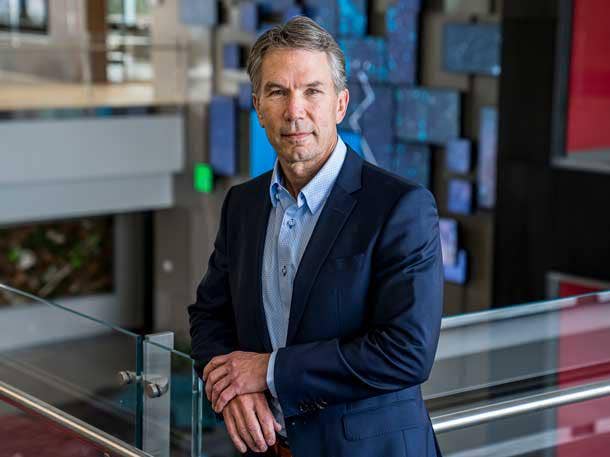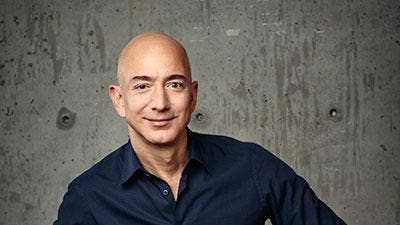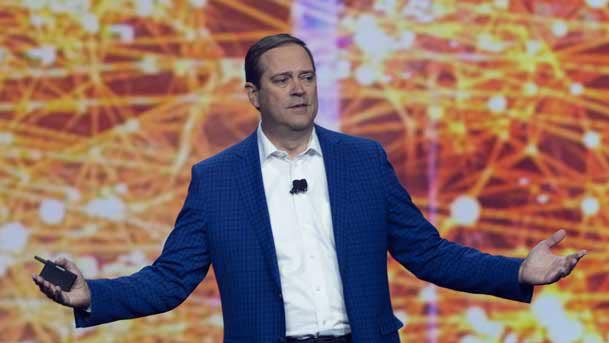WWT’s CEO On Jeff Bezos, Cisco’s Future And SolarWinds Hack
‘As large as Amazon is on both the cloud side and I’ll call it the retail side of what they do, to bring in their technologist to lead the company, that’s something that they are leaning toward: technologists to drive the future of that business along with Bezos still being intimately involved in where they’re going,’ says WWT CEO Jim Kavanaugh.

Kavanaugh’s View Of Cisco, Amazon And Cybersecurity In 2021
World Wide Technology CEO Jim Kavanaugh has guided his company from a small startup to a $13.4 billion IT behemoth over the past three decades. Kavanaugh, who was a professional soccer player before co-founding WWT in 1990, understands where the technology puck is heading better than most.
In an interview with CRN, the channel icon discusses Cisco’s future in as-a-service, WWT’s plan to hire 1,000 new employees this year, and Amazon CEO Jeff Bezos handing the baton to AWS CEO Andy Jassy.
“ I don’t believe that Bezos is going away. Andy Jassy is going to have Jeff Bezos close to him, and they’re going to be collaborating,” said Kavanaugh.
WWT’s CEO also talks about the biggest takeaways from the massive SolarWinds hack that rocked the IT world as well as his advice to channel partners on how to combat such security issues.
“There needs to be a collaborative effort between IT, the line of business, the policies in place, but also trying to reduce the number of technology security products that you have in your environment to standardize on,” Kavanaugh said.

What’s your take on Amazon’s Jeff Bezos handing over the reins to AWS’ Andy Jassy?
AWS and Jeff Bezos (pictured) are just so impressive. They’ve defied a lot of odds out there and I think proved a lot of people wrong regarding the maniacal focus he’s had investing long term. I don’t believe that Bezos is going away. Andy Jassy is going to have Jeff Bezos close to him, and they’re going to be collaborating.
It’s interesting. As large as Amazon is on both the cloud side and I’ll call it the ‘retail’ side of what they do, to bring in their technologist to lead the company, that’s something that they are leaning toward: technologists to drive the future of that business along with Bezos still being intimately involved in where they’re going. They’re an impressive company.
We literally have two entrepreneurs and innovators that will be recognized for many, many years to come. If you look at Bezos and Elon Musk, they will be in the history books a long time based on the things they’ve done and will continue to do.

What big lesson should be learned from the massive SolarWinds hack?
There’s a mindset that everybody needs to understand: It’s not if you get hacked, it’s when you get hacked. It’s becoming very pervasive at this point. You have to come together to figure out how do you put the safest environment and the most secure environment in place that is possible. But you also have to keep in mind that you need to keep an agile and nimble organization. Because if you lock down everything to such a degree, you may actually put yourself out of business. It’s an absolute challenge to balance those things: speed, flexibility, agility and driving digital acceleration.
In the spirit of the Internet of Things and all these devices being enabled, those are just additional endpoints that can be breached. So everything is becoming automated—from your lights and your doorbell to video to driverless cars. All of those things also need to be secured. Unfortunately, I would love to say there’s a silver bullet to go do that, but I don’t believe there is.

What is your security advice to prevent another SolarWinds-type breach?
For you to actually integrate and enforce the most secure environment for a company, you need to blend technology and policy. The policy and the operating structure of the company need to be aligned to what you’re doing from a technology perspective. Those worlds need to come together to drive the most secure environment.
What a lot of the CISOs are dealing with is there’s such a barrage of individual security technology products and it’s so hard for those individuals to evaluate all those products. To build a secure network and environment, you need to look at standardizing certain things to mitigate not having too many devices or too many different products in your environment that literally overcomplicate things and create additional complexity. This is just a world that we have to embrace. It’s not going to go away. The hacking isn’t going to go away. The threats aren’t going to go away. The need to technology-enable and digitize a business is not going to go away.
There needs to be a collaborative effort between IT, the line of business, the policies in place, but also trying to reduce the number of technology security products that you have in your environment to standardize on.

Is Cisco’s massive as-a-service charge in 2021 the right strategy?
I think they are going in the right direction. I know [Cisco Chairman and CEO] Chuck Robbins (pictured) very well and I talk to Chuck quite a bit. Obviously, our business is linked with Cisco. Overall, I think they’re doing the right thing. I don’t think Cisco is trying to overcorrect too fast, but they are moving aggressively into Software as a Service, these enterprise software licensing and enterprise software agreements with customers that basically open up the Cisco portfolio of hardware and software.
The key is we’re helping Cisco and the customer with not only understanding what that portfolio is made up of, but making sure that if you’re going to buy that hardware and software that you adopt it and integrate it and you get the benefit and value out of that software. Because that creates a win-win for Cisco and the customer. Because a lot of times, over the years, many companies have bought a lot of software from different companies and, at times, they may use only 10 percent of the functionality of that software. So our goal is to build these consulting services and life-cycle services that help customers evaluate what are they buying, why are they buying it, and then how do you make sure you implement that in a very productive and optimized way.

Is WWT doubling down on Microsoft Teams, Zoom or Cisco Webex in 2021?
I have anywhere from three to 15 calls a day, it varies, and I could be on any one of those platforms. It’s going to be the ones that build a platform that they continue to innovate and iterate faster than the others. If you look at the emergence of Zoom, I think Zoom has pushed Cisco and Microsoft in a way that they probably would not have moved quite as quickly as they’re trying to move now because of where Zoom is. It’s actually good for the market.
From a WWT perspective, we’re a very large Cisco partner and they are a very strategic partner of ours. But we still have to be able to advise our customers on the features, functionalities and what products fit best to provide a level of independence. That is a perfect example of where we can help customers really sort through what is the best solution for them based on the things that they need. Those are three very formidable competitors that I think are basically good for the market.

What does WWT’s hiring forecast look like in 2021?
Even during COVID we hired 600 or 700 people last year. We have a budget this year to hire over 1,000 people. We’re watching the market very closely as we still continue to work through the pandemic and some macroeconomic things both domestically and globally. With that being said, we have plans to continue to grow this year.
The last two years we have grown 12 [percent] to 15 percent top line, bottom line, which is part of our five-year plan. The largest areas of investment and growth that we’re looking at is around services and those areas would tie to things like software development in our digital portfolios. So as we go out and design and implement mobile-based solutions, web-based solutions, digital solutions, digital strategy implementation, etc. ,we have the software side as well as management consultants that go along working with those software engineers.
Also, big data and AI is an area of growth for us. Security is another big area of growth. We’re also watching some of the networking pieces as 5G starts to take hold, and the type of engineers and architects that are going to be required to help customers build out some of their networks and leverage that capability. The last area is cloud. We have a big focus on helping customers evaluate private, public, hybrid cloud and how that aligns with Microsoft, Amazon and Google.